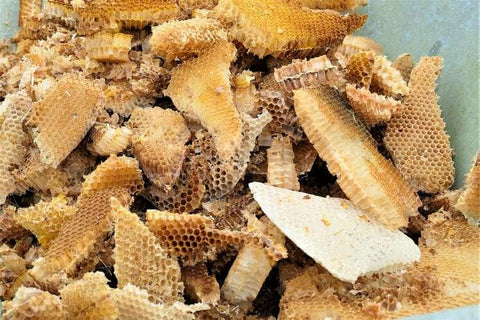
Premium Raw Beeswax from Foxadise Farms - A Natural Wonder
At Foxadise Farms, we are passionate about providing high-quality, natural products that celebrate the wonders of the hive. Our Raw Beeswax is a testament to this commitment. Carefully harvested and gently filtered to remove only large debris, our beeswax retains its rich, natural color and the subtle sweet scent of honey.
We offer our pure raw beeswax for sale by the pound, allowing you to purchase the perfect amount for your needs.
Ideal for:
-
Candle Makers: Enjoy clean-burning, naturally fragrant candles made with pure beeswax. Purchase by the pound for larger projects or to ensure you always have this essential ingredient on hand.
-
Craft Enthusiasts: Discover the endless possibilities of this versatile natural material in your creative endeavors. Buying by the pound gives you the flexibility to experiment with different projects.
-
Natural Skincare: Create your own nourishing and protective balms and lotions. Our beeswax, sold by the pound, ensures you have a consistent supply for your homemade skincare creations.
-
Fellow Beekeepers: Use our raw beeswax for your own hive management needs. Purchase the exact quantity you require by the pound.
Support sustainable beekeeping and experience the exceptional quality of Foxadise Farms Raw Beeswax.
The primary ingredients of raw beeswax are complex mixtures of:
Esters: These are the most abundant components, making up the bulk of beeswax. They are mainly esters of long-chain fatty acids and long-chain alcohols.
Free Fatty Acids: Beeswax contains various free fatty acids.
Hydrocarbons: These are also present in a significant amount.
Free Fatty Alcohols: Similar to free fatty acids, beeswax contains free fatty alcohols.
Pollen: As mentioned earlier, the mixing of pollen oils contributes to the color and some properties of beeswax.
Propolis: Trace amounts of propolis, a resinous mixture that honey bees collect from tree buds, might also be present depending on the processing level.
The exact composition can vary slightly depending on the bee species, the flowers they visit, and the processing methods used (though raw beeswax is minimally processed).
Here's some additional information about raw beeswax:
How Bees Produce Beeswax:
Beeswax is secreted by worker bees from eight wax-producing glands located on the underside of their abdomens.
When it's time to build honeycomb, these glands secrete a clear, liquid wax that hardens into small flakes or scales upon contact with the air.
The bees then chew these wax scales with their mandibles, adding saliva and enzymes, which softens the wax and makes it pliable for building the honeycomb structure.
Scent and Color Variations:
Color: Raw beeswax can range in color from pale yellow to dark brown. The color depends on factors like the age of the wax and the types of flowers the bees collected nectar from. Wax used for brood rearing tends to be darker due to impurities from the cocoons and pollen.
Scent: Raw beeswax typically has a natural, sweet aroma of honey. The specific scent can also vary depending on the floral sources the bees visited. Some beeswax may have a mild and sweet scent, while others might have a slightly more floral or even woodsy note.
Storing Raw Beeswax:
To maintain its quality, raw beeswax should be stored in a cool, dry place away from direct sunlight and heat sources.
An airtight container, such as a glass jar with a tight-fitting lid, is ideal for storage to protect it from dust and moisture.
While some suggest refrigeration or freezing, it's generally not recommended as condensation can occur. If you must use these methods, ensure the beeswax is in an airtight container and allow it to return to room temperature slowly before opening.
Sustainability of Beeswax:
When harvested responsibly, beeswax production is considered sustainable as it is a natural byproduct of honey production.
Using beeswax can be seen as supporting healthy bee colonies, which are crucial for pollination and the ecosystem.
Beeswax candles are also considered more environmentally friendly than paraffin candles as they burn cleaner and may even help to purify the air by emitting negative ions.
Historical Uses of Beeswax:
Humans have utilized beeswax for thousands of years. Some historical uses include:
Waterproofing: Ancient people likely used beeswax to waterproof pottery and other materials.
Adhesive: It was mixed with resin to create adhesives.
Cosmetics: Beeswax has been used in cosmetics and skincare for its moisturizing properties since ancient times.
Mummification: The ancient Egyptians used beeswax in their mummification processes.
Writing Tablets: In ancient times, wax tablets were used for writing.
Lost-Wax Casting: Beeswax has been essential in the lost-wax casting process for creating metal sculptures.
Candles: Beeswax candles were one of the earliest forms of lighting.
Hopefully, this additional information gives you a more comprehensive understanding of raw beeswax!